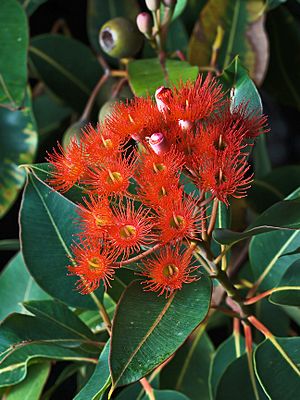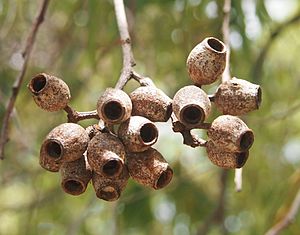Bloodwoods facts for kids
Quick facts for kids Bloodwoods |
|
|---|---|
 |
|
| Corymbia ficifolia near Austins Ferry | |
| Scientific classification |
|
| Kingdom: | Plantae |
| Clade: | Tracheophytes |
| Clade: | Angiosperms |
| Clade: | Eudicots |
| Clade: | Rosids |
| Order: | Myrtales |
| Family: | Myrtaceae |
| Subfamily: | Myrtoideae |
| Tribe: | Eucalypteae |
| Genus: | Corymbia K.D.Hill & L.A.S.Johnson |
| Type species | |
| Corymbia gummifera (Gaertn.) K.D. Hill & L.A.S. Johnson
|
|
| Diversity | |
| about 113 species | |

Corymbia is a group of about 100 types of trees. These trees, along with Eucalyptus and Angophora, are often called "eucalypts". For a long time, Corymbia trees were thought to be part of the Eucalyptus group. However, in 1990, scientists decided they were different enough to be their own group. Most botanists now agree that Corymbia is a separate genus.
Contents
What do Corymbia trees look like?
Corymbia trees can be tall trees or smaller, bushy plants called mallees. Their bark can be rough and stringy, or smooth and flaky. The bark often peels off in small pieces.
Leaves, Flowers, and Fruit
Young Corymbia plants have leaves that look different from the leaves on older trees. Adult leaves grow in an alternating pattern along the branches. They also have special oil glands inside them.
The flowers grow in clusters. Each cluster usually has seven flower buds. These buds are arranged in a flat-topped or rounded shape. Like Eucalyptus flowers, Corymbia flowers have two caps that cover the flower parts. These caps fall off when the flower opens. The fruit is usually a woody capsule, which is like a hard seed pod. The seeds are held inside this capsule.
How Corymbia got its name
The group Corymbia was officially named in 1995. It was named by two botanists, Ken Hill and Lawrie Johnson. The name Corymbia comes from the Latin word corymbus. This word describes a type of flower cluster where the flowers grow at different heights but form a flat top.
Separating from Eucalyptus
For many years, the trees now called Corymbia were part of the large Eucalyptus group. But even back in 1867, people noticed they were a bit different. In the 1990s, scientists used DNA research to study these trees. They found that Corymbia trees were actually more closely related to Angophora trees than to Eucalyptus trees. Because of this, Corymbia was made into its own separate group.
Even though they are now separate, Angophora, Corymbia, and Eucalyptus are all still very closely related. They are all commonly known as "eucalypts."
Where Corymbia trees grow
You can find Corymbia trees in all the mainland states of Australia. They also grow in the Northern Territory. There are about 100 different types of Corymbia species. Most of them are found only in Australia. However, four species also grow in New Guinea, and one species is found only in New Guinea.
Images for kids
See also
 In Spanish: Corymbia para niños
In Spanish: Corymbia para niños




